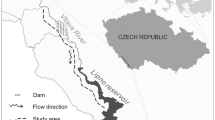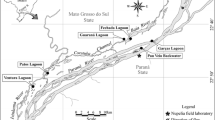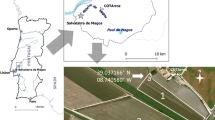Synopsis
Extensive upstream migration of landlocked Arctic charr during spring floods was recorded in several tributaries of an oligotrophic lake in north-west Sweden. Migration was confined to a period of about two weeks and residence in most creeks was of short duration. Only fish migrating to two small productive lakes remained in the new habitat over the summer. Repeated annual migrations were only recorded in the creek leading to these lakes and no straying was observed among repeat migrants. Water temperatures provided the primary cues for initiation and direction of migration, although an ability to detect productive habitats by odour was indicated. Creek size, feeding opportunities during migration and conspeeific odour were subordinate guiding factors.
Similar content being viewed by others
References cited
Armstrong, R.H. 1974. Migrations of anadromous dolly varden (Salvelinus malma) in southeastern Alaska. J. Fish. Res. Board Can. 31: 435–444.
Baker, R.R. 1978. The evolutionary ecology of animal migration. Hodder & Stoughton, London. 1012 pp.
Black, G.A. & J.B. Dempson. 1986. A test of the pheromone hypothesis of pheromone attraction in salmonid migration. Env. Biol. Fish. 15: 229–235.
Brannon, E.L. 1972. Mechanisms controlling migration of sockeye salmon fry. Int. Pac. Salm. Fish. Comm. Bull. 21: 1–86.
Brown, T.G. & G.F. Hartman. 1988. Contribution of seasonally flooded lands and minor tributaries to the production of coho salmon in Carnation Creek, British Columbia. Trans. Amer, Fish. Soc. 117: 546–551.
Craig, P.C. & V.A. Poulin. 1975. Movements and growth of Arctic grayling (Thymallus arcticus) and juvenile Arctic char (Salvelinus alpinus) in a small Arctic stream, Alaska. J. Fish. Res. Board Can. 32: 48–52.
Dodson, J.J. 1988. The nature and role of learning in the orientation and migratory behaviour of fishes. Env. Biol. Fish. 23: 161–182.
Gross, M.R., R.M. Coleman & R.M. McDowall. 1988. Aquatic productivity and the evolution of diadromous fish migration. Science 239: 1290–1293.
Hammar, J. & O. Filipsson. 1985. Ecological testfishing with the Lundgren gillnets of multiple mesh size: the Drottningholm technique modified for Newfoundland Arctic char populations. Rep. Inst. Freshw. Res. Drottningholm 62: 12–35.
Hartman, G.F. & T.G. Brown. 1987. Use of small temporary floodplain tributaries by juvenile salmonids in a west-coast rain forest drainage basin, Carnation Creek. British Columbia. Can. J. Fish. Aquat. Sci. 44: 262–270.
Hynes, H.B.N. 1977. The ecology of running waters. University of Toronto Press, Toronto. 555 pp.
Johnson, L. 1980. The Arctic charr, Salvelinus alpinus. pp. 15–98. In: E.K. Balon (ed.) Charrs: Salmonid Fishes of the Genus Salvelinus, Dr W. Junk Publishers, The Hague.
Jonsson, B. & F.R. Gravem. 1985. Use of space and food by resident and migrant brown trout, Salmo trutta. Env. Biol. Fish. 14: 281–293.
Jonsson, B., N. Jonsson & L.P. Hansen. 1990. Does juvenile experience affect migration and spawning of adult Atlantic salmon? Behav. Ecol. Sociobiol. 26: 225–230.
McBride. D.N. 1980. Homing of Arctic char, Salvelinus alpinus (Linnaeus) to feeding and spawning sites in the Wood River lake system, Alaska. Alaska Department of Fish and Game. Inf. leaflet 184. 23 pp.
McCart, P.J., P. Craig & H. Bain. 1972. Report on fisheries investigations in the Sagavanirktok river and neighbouring drainages. Alyeska Pipeline Service Company, Bellevue. 170 pp.
McCleave, J.D., G.W. LaBar & F.W. Kirches. 1977. Within-season movements of displaced sunapee trout (Salvelinus alpinus) in Floods pond, Maine. Trans. Amer, fish. Soc. 106: 156–162.
McKeown, B.A. 1984. Fish migration. Timber press, Beaverton. 212 pp.
Nordeng, H. 1971. Is the local orientation of anadromous fishes determined by pheromones? Nature 233: 411–413.
Northcote, T.G. 1969. Patterns and mechanisms in the lakeward migratory behaviour of juvenile trout. pp. 183–203. In: T.G. Northcote (ed.) Symposium on Salmon and Trout in Streams, University of British Columbia, Vancouver.
Northcote, T.G. 1978. Migratory strategies and production in fresh water fishes. pp. 326–359. In: S.D. Gerking (ed.) Ecology of Freshwater Fish Production, Blackwell Scientific Publications, Oxford.
Northcote, T.G. 1984. Mechanisms of fish migrations in rivers. pp. 317–355. In: J.D. McCleave, G.P. Arnold, J.J. Dodson & W.H. Neill (ed.) Mechanisms of Migration in Fishes, Plenum Press, New York.
Näslund, I. 1989. Seasonal habitat shifts in salmonids; possible mechanisms behind upstream migrations. pp. 147–151. In: E. Brannon & B. Jonsson (ed.) Salmonid Migration and Distribution Symposium, Trondheim.
Näslund, I. 1990. The development of regular seasonal habitat shifts in a landlocked Arctic charr, Salvelinus alpinus, population. J. Fish Biol. 36: 401–414.
O'Connor, J.F. & G. Power. 1973. Homing of brook trout (Salvelinus fontinalis) in Matamek lake, Quebec. J. Fish. Res. Board Can. 19: 327–364.
Olsèn, H. 1985. Chemoreceptive behaviour in Arctic charr, Salvelinus alpinus (L.). Response to conspecific scent and nitrogenous metabolites. Doctoral Dissertation, Uppsala University, Uppsala. 43 pp.
Ricker, W.E. 1975. Computation and interpretation of biological statistics of fish populations. Bull. Fish. Res. Board Can. 191. 382 pp.
Selset, R. & K.B. Döving. 1980. Behaviour of anadromous Arctic char (Salmo alpinus L.) towards odorants produced by smolts of their own population. Acta Physiol. Scand. 108: 113–122.
Smith, R.J.F. 1985. The control of fish migration. Springer-Verlag, Berlin. 243 pp.
Stuart, T.A. 1957. The migration and homing behaviour of brown trout (Salmo trutta L.). Scottish Home Department, Freshw. Fish. Res. 18: 1–27.
Sömme, J.D. 1941. Örretboka. Dybwalds Forlag, Oslo. 585 pp (In Norwegian.)
Völlestad, L.A. & B. Jonsson. 1988. A 13-year study of the population dynamics and growth of the European eel (Anguilla anguilla) in a Norwegian river: evidence for density-dependent mortality, and development of a model for predicting yield. J. Anim. Ecol. 57: 983–997.
Author information
Authors and Affiliations
Rights and permissions
About this article
Cite this article
Näslund, I. Upstream migratory behaviour in landlocked Arctic charr. Environ Biol Fish 33, 265–274 (1992). https://doi.org/10.1007/BF00005870
Received:
Accepted:
Issue Date:
DOI: https://doi.org/10.1007/BF00005870




